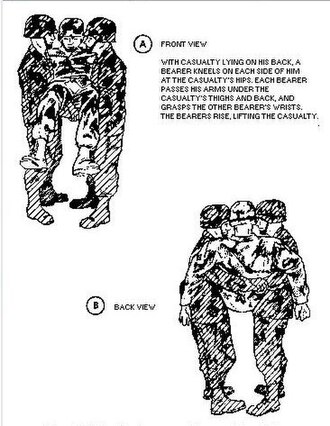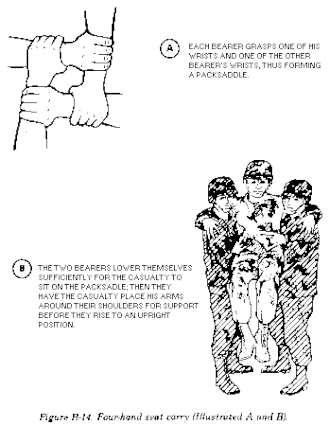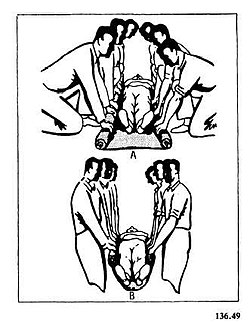AY Honors/Basic Rescue/Answer Key
1. What is the definition of an emergency rescue?
A rescue is the act of removing someone from danger. An Emergency Rescue is a technical term for a rescue taking place under hazardous circumstances and with high risk to the rescue personel, but must be done immediately to save a person's life. In this type of scenario to say a person is in immediate danger may be understated, normally if not removed from their circumstance as quickly as possible the victim will die quite soon. Technical rescues and rescue are descriptive of many types of circumstances, in all cases the victim is in danger. A cat up a tree or an otherwise uninjured person stuck in a crashed car are not likely to die in moments but will need to be rescued from their circumstance by someone with the means and skill to do so.
2. Show how to safely rescue a person from the following situations:
a. Being in contact with a live electric wire
Adventist Youth Honors Answer Book/First aid/Electric wire contact
b. A room filled with fumes or smoke
Adventist Youth Honors Answer Book/First aid/Smoke fire
c. Clothes on fire
Adventist Youth Honors Answer Book/First aid/Clothes on fire
d. Drowning using a non-swimming rescue
Adventist Youth Honors Answer Book/First aid/Non-swimming rescue
e. An ice accident
Adventist Youth Honors Answer Book/First aid/Ice rescue
3. Show three ways of attracting and communicating with rescue aircraft.
Adventist Youth Honors Answer Book/First aid/Signaling aircraft
4. Know six indications for the need of an immediate rescue.
- The victim has stopped breathing
- The victim has severe bleeding
- The victim has is being electrically shocked
- The victim has a heart attack
- There is a fire
- The victim is drowning
- The victim has been poisoned
5. Know six procedures to follow before moving a victim from a life-threatening situation.
- The first task is to assess the whole situation and to plan the rescue.
- Be sure you can perform the rescue without injuring yourself.
- Make sure that moving the victim will not cause additional injury.
- Know where you intend to move the victim before lifting him.
- If bystanders must be used, it is essential that they be briefed in thorough detail on what you want them to do.
- Unless the danger is immediate, any first aid should be given before moving the victim.
- If you suspect a spinal injury, do not move the victim.
6. Know five principles involved in moving a victim from a life-threatening situation
- Be sure that it is necessary to move the victim. If it is not, do not move the victim.
- Know how you will move the victim before trying to move him.
- Know where you will move the victim before trying to move him.
- Be sure that you are able to lift the victim before lifting him. If the victim is too heavy, drag him instead.
- Maintain your balance. Do not start the move from an unbalanced position.
- Keep your footing throughout the move.
7. Know the proper ways to help a victim, without assistance, in the following:
a. Pulling the victim
Adventist Youth Honors Answer Book/First aid/Shoulder drag
Adventist Youth Honors Answer Book/First aid/Blanket drag
b. Lifting the victim
Adventist Youth Honors Answer Book/First aid/Firemans carry
Adventist Youth Honors Answer Book/First aid/Pack strap carry
c. Assisting a victim in walking
Adventist Youth Honors Answer Book/First aid/Support carry
8. Know the proper way to help a victim, with assistance, in the following:
a. Chair carry
b. Fore-and-aft carry

c. Two-handed and four-handed seats
The two-hand seat carry is used in carrying a casualty for a short distance and in placing him on a litter.
Only a conscious casualty can be transported with the four-hand seat carry because he must help support himself by placing his arms around the bearers' shoulders. This carry is especially useful in transporting the casualty with a head or foot injury and is used when the distance to be traveled is moderate. It is also useful for placing a casualty on a litter.
d. Blanket carry
The casualty is placed in the middle of the blanket lying on his back. Three or four people kneel on each side and roll the edges of the blanket toward the casualty, as shown in part A of the figure. When the rolled edges are tight and large enough to grasp securely, the casualty should be lifted and carried as shown in part B of the figure.
e. Three-man hammock carry with victim in supine and prone position
f. Three- or four-man lift
g. Six-man lift and carry
9. Know how to properly use a stretcher and carry a victim on a stretcher. Know how to make an improvised litter.
Adventist Youth Honors Answer Book/First aid/Litter carry
Adventist Youth Honors Answer Book/First aid/Improvised litter
10. Know how to properly use ropes and knots as follows:
a. Tie knots for joining ropes together
Template:Knot square Do not let life depend on a square knot. It is unreliable. Its proper use in basic rescue is in securing the ends of a bandage.
b. Tie knots for shortening a rope
c. Tie knots for use around a person for a rescue
d. Coil and accurately throw a light and a heavy 50-foot (15.2 m) rope.
Seperate the rope into two equal sized coils, with a little less than half the rope in each coil. Choose one end that you will hang on to, and grasp it firmly in the palm of one hand, using the three smallest fingers to hold it securely. Hold the rest of that coil between the index finger and thumb, and hold the other coil in the other hand. Take aim, and throw both coils toward the victim at the same time while retaining your grip on the end. If you have difficulty with this, try standing on the end of the rope you wish to keep with you. Using this method, you can throw the rope quite a bit farther than if you had thrown a single coil. This is because the second coil will not begin to unravel until the first one uncoils. Practice until you can hit a target with the rope from the 50-foot (15 meter) mark.



